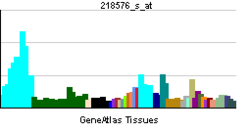- DUSP12
-
Dual specificity phosphatase 12 Identifiers Symbols DUSP12; DUSP1; YVH1 External IDs OMIM: 604835 MGI: 1890614 HomoloGene: 5238 GeneCards: DUSP12 Gene Gene Ontology Molecular function • protein tyrosine phosphatase activity
• protein tyrosine/serine/threonine phosphatase activity
• zinc ion binding
• hydrolase activity
• kinase binding
• metal ion bindingCellular component • intracellular
• nucleus
• cytoplasmBiological process • protein modification process
• protein dephosphorylation
• JNK cascade
• positive regulation of glucokinase activity
• peptidyl-tyrosine dephosphorylationSources: Amigo / QuickGO RNA expression pattern 
More reference expression data Orthologs Species Human Mouse Entrez 11266 80915 Ensembl ENSG00000081721 ENSMUSG00000026659 UniProt Q9UNI6 Q4KL39 RefSeq (mRNA) NM_007240 NM_023173.2 RefSeq (protein) NP_009171 NP_075662.2 Location (UCSC) Chr 1:
161.72 – 161.73 MbChr 1:
172.8 – 172.82 MbPubMed search [1] [2] Dual specificity protein phosphatase 12 is an enzyme that in humans is encoded by the DUSP12 gene.[1][2]
The protein encoded by this gene is a member of the dual specificity protein phosphatase subfamily. These phosphatases inactivate their target kinases by dephosphorylating both the phosphoserine/threonine and phosphotyrosine residues. They negatively regulate members of the mitogen-activated protein (MAP) kinase superfamily (MAPK/ERK, SAPK/JNK, p38), which is associated with cellular proliferation and differentiation. Different members of the family of dual specificity phosphatases show distinct substrate specificities for various MAP kinases, different tissue distribution and subcellular localization, and different modes of inducibility of their expression by extracellular stimuli. This gene product is the human ortholog of the Saccharomyces cerevisiae YVH1 protein tyrosine phosphatase. It is localized predominantly in the nucleus, and is novel in that it contains, and is regulated by a zinc finger domain.[2]
References
- ^ Muda M, Manning ER, Orth K, Dixon JE (Sep 1999). "Identification of the human YVH1 protein-tyrosine phosphatase orthologue reveals a novel zinc binding domain essential for in vivo function". J Biol Chem 274 (34): 23991–5. doi:10.1074/jbc.274.34.23991. PMID 10446167.
- ^ a b "Entrez Gene: DUSP12 dual specificity phosphatase 12". http://www.ncbi.nlm.nih.gov/sites/entrez?Db=gene&Cmd=ShowDetailView&TermToSearch=11266.
Further reading
- Hasstedt SJ, Chu WS, Das SK, et al. (2008). "Type 2 diabetes susceptibility genes on chromosome 1q21-24.". Ann. Hum. Genet. 72 (Pt 2): 163–9. doi:10.1111/j.1469-1809.2007.00416.x. PMID 18269685.
- Das SK, Chu WS, Hale TC, et al. (2006). "Polymorphisms in the glucokinase-associated, dual-specificity phosphatase 12 (DUSP12) gene under chromosome 1q21 linkage peak are associated with type 2 diabetes.". Diabetes 55 (9): 2631–9. doi:10.2337/db05-1369. PMID 16936214.
- Gregory SG, Barlow KF, McLay KE, et al. (2006). "The DNA sequence and biological annotation of human chromosome 1.". Nature 441 (7091): 315–21. doi:10.1038/nature04727. PMID 16710414.
- Rual JF, Venkatesan K, Hao T, et al. (2005). "Towards a proteome-scale map of the human protein-protein interaction network.". Nature 437 (7062): 1173–8. doi:10.1038/nature04209. PMID 16189514.
- Gerhard DS, Wagner L, Feingold EA, et al. (2004). "The status, quality, and expansion of the NIH full-length cDNA project: the Mammalian Gene Collection (MGC).". Genome Res. 14 (10B): 2121–7. doi:10.1101/gr.2596504. PMC 528928. PMID 15489334. http://www.pubmedcentral.nih.gov/articlerender.fcgi?tool=pmcentrez&artid=528928.
- Strausberg RL, Feingold EA, Grouse LH, et al. (2003). "Generation and initial analysis of more than 15,000 full-length human and mouse cDNA sequences.". Proc. Natl. Acad. Sci. U.S.A. 99 (26): 16899–903. doi:10.1073/pnas.242603899. PMC 139241. PMID 12477932. http://www.pubmedcentral.nih.gov/articlerender.fcgi?tool=pmcentrez&artid=139241.
- Groom LA, Sneddon AA, Alessi DR, et al. (1996). "Differential regulation of the MAP, SAP and RK/p38 kinases by Pyst1, a novel cytosolic dual-specificity phosphatase.". EMBO J. 15 (14): 3621–32. PMC 451978. PMID 8670865. http://www.pubmedcentral.nih.gov/articlerender.fcgi?tool=pmcentrez&artid=451978.
Esterase: protein tyrosine phosphatases (EC 3.1.3.48) Class I Classical PTPsReceptor type PTPs (PTPRA, PTPRB, PTPRC, PTPRD, PTPRE, PTPRF, PTPRG, PTPRH, PTPRJ, PTPRK, PTPRM, PTPRN, PTPRN2, PTPRO, PTPRQ, PTPRR, PTPRS, PTPRT, PTPRU, PTPRZ)
Non receptor type PTPs (PTPN1, PTPN2, PTPN3, PTPN4, PTPN5, PTPN6, PTPN7, PTPN9, PTPN11, PTPN12, PTPN13, PTPN14, PTPN18, PTPN20, PTPN21, PTPN22, PTPN23MAPK phosphatases (MKPs) (DUSP1, DUSP2, DUSP4, DUSP5, DUSP6, DUSP7, DUSP8, DUSP9, DUSP10, DUSP16, MK-STYX)
CDC14s (CDC14A, CDC14B, CDKN3, PTP9Q22)
Atypical DSPs (DUSP3, DUSP11, DUSP12, DUSP13A, DUSP13B, DUSP14, DUSP15, DUSP18, DUSP19, DUSP21, DUSP22, DUSP23, DUSP24, DUSP25, DUSP26, DUSP27, EMP2A, RNGTT, STYX)
Phosphatase and tensin homologs (PTENs) (PTEN, TPIP, TPTE, TNS, TENC1)
Myotubularins (MTM1, MTMR2, MTMR3, MTMR4, MTMR5, MTMR6, MTMR7, MTMR8, MTMR9, MTMR10, MTMR11, MTMR12, MTMR13, MTMR14, MTMR15)Class II Class III Class IV B enzm: 1.1/2/3/4/5/6/7/8/10/11/13/14/15-18, 2.1/2/3/4/5/6/7/8, 2.7.10, 2.7.11-12, 3.1/2/3/4/5/6/7, 3.1.3.48, 3.4.21/22/23/24, 4.1/2/3/4/5/6, 5.1/2/3/4/99, 6.1-3/4/5-6 Categories:- Human proteins
- Chromosome 1 gene stubs
Wikimedia Foundation. 2010.
